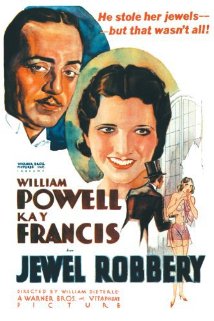
JEWEL ROBBERY
US, 1932, 68 minutes, Black and white.
William Powell, Kay Francis, Helen Vinson, Hardie Albright, Alan Mowbray.
Directed by William Diertele.
Jewel Robbery is a very light entertainment from 1932, a brief running time, with the star power of the urbane William Powell and the attractive Kay Francis, both of whom had significant careers during the 1930s. Direction is by William Diertele who directed films during the 1920s in his native Germany, moved to the United States directing small budget films until his biographical stories at Warner Brothers in the mid 1930s, biographies of Louis Pasteur, Emile Zola, fantasies and thrillers during the 1940s and the first half of the 1950s, after which he returned to Germany and was prolific in directing films in his native country until the end of the 1960s.
The action of this film takes place over a couple of days, a focus on Kay Francis, a pampered and wealthy woman of Vienna, married to an order man she does not love but who buys her jewellery and all she desires. She relies very much on her friend and confidant, Marianne, played by Helen Vinson.
In the meantime, there are a number of daring robberies in jewellery shops in Vienna, all taking place in broad daylight. At one store, an inventor is installing electric beams to trap robbers – only to find that he is too late and the shop has been already robbed.
Kay Francis and her friends and husband or go to the jewel shop where she hopes her husband will buy her a diamond ring. A member of the ministry also turns up – with indications that he has been having a fling with Kay Francis who now wants to break it off.
Then, robbery happens in broad daylight, William Powell being the gentlemanly thief, with quite a group of associates who hold up everyone and systematically clear the shop of all its jewellery. When the police arrive, Kay Francis is not sure that she can identify the thief. When she goes home, she finds the ring in her safe and Powell turns up, flirts with her, in hopes of a future liaison.
Many commentators have pointed out that this is a film from the pre-Motion Picture Code era. William Powell hands out marijuana cigarettes to the security guard and the police officer who are shown having quite a high. And there is plenty of innuendo in the dialogue, especially with situations of marital infidelity – and on the whole a tone that was considered racy at the time. For those used to seeing films from this period, it may seem surprisingly racy.
All in all, it is a piece of froth, a chance to glamorise Kay Francis and to show how debonair William Powell could be.